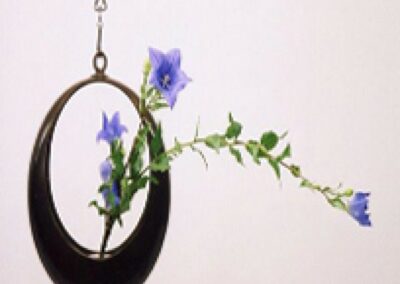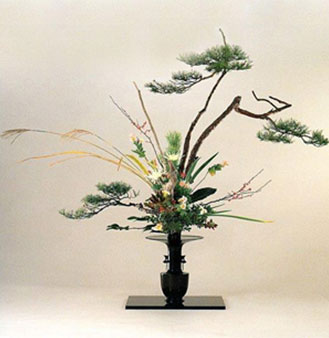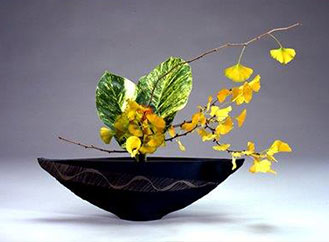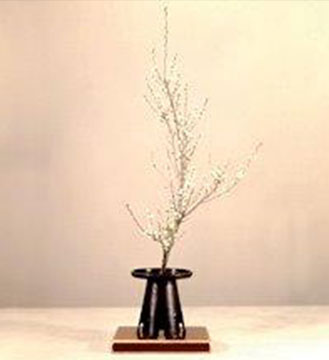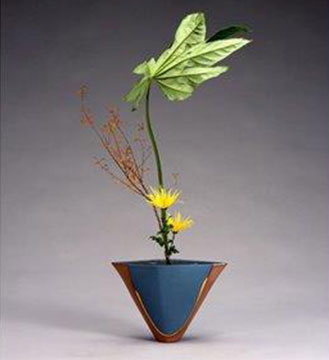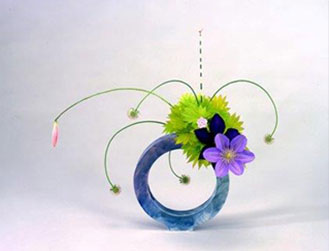With each new Ikebana arrangement, IKENOBO continues a tradition of creativity that began over 550 years ago. IKENOBO is based in Kyoto, Japan, at Choho-ji (Rokkaku-do) Temple, a temple said to have been founded by Prince Shotoku.
IKENOBO’s current 45th generation Headmaster, Sen’ei Ikenobo, believes that the possibility of creating new Ikebana depends on the desire to refine one’s own character, a spirit that has been passed down to us as the essence of Ikebana itself.
As a continuing center in the world of Ikebana, the IKENOBO Headquarters stands adjacent to Rokkaku-do Temple, where Ikebana began over 550 years ago. The Headquarters is home for communication, ongoing, study, and workshops for IKENOBO’s Ikebana professors and students from throughout Japan and the rest of the world. Here at the center of IKENOBO’s rich tradition, students receive both classical training and encouragement to explore modern Ikebana’s use in contemporary life, including modern rikka, shoka, and free styles.
1. RIKKA: a style with ancient roots, contributing to contemporary life
From the 14th through 16th centuries, a formal study with a window and writing shelf became part of Japanese architectural design. A low rectangular board (oshi-ita) provided a place for appreciation of the tatehana style of Ikebana, precursor to rikka. Later, a room having a tokonoma (formal alcove) developed from this style of room design. Rikka displayed in a tokonoma was an important way of welcoming guests, and it can be said that the rikka developed as a style suited for display in the space provided by the tokonoma.
Rikka today is divided into two main styles, contemporary rikka shimputai, and traditional rikka shofutai.
Characteristics of rikka shofutai
Rikka shofutai is arranged based on a traditional esthetic of rikka style, employing seven or nine main stems in composing a basic pattern. Complex and varied composition contribute to the character of this style, arranged to express the vast beauty of nature.
This new rikka style, arranged with a knowledge of the composition and esthetics of traditional rikka, emphasizes expressiveness via the movement, brightness, and fresh impressions given by its floral materials. A wide variety of floral materials can be used, with contrast and the unexpected contributing to an overall effect of brightness, sharpness, and distinctiveness.
2. SHOKA: bringing beauty to everyday life
Shussho, or the essential inner character of each plant variety, is considered most important when arranging shoka style. This inner character of the plant governs its basic growth. As the plant puts out leaves and flowers, natural environmental factors such as light and weather uniquely affect the growth of individual plants. Shoka style reflects both the inner character of the plant variety and the bright energy of life filling each individual plant as it grows.
Shoka today is divided into two main styles, contemporary shoka shimputai, and traditional shoka shofutai.
Characteristics of shoka shofutai
Traditional shoka shofutai is composed of three main parts called shin, soe, and tai, containing within them ancient principles of heaven, man, and earth, and in (yin) and yo (yang). The characteristic beauty of shoka comes from the clean, straight line of stems at the base of the arrangement, called mizugiwa. Stems above the mizugiwa move upward in harmony with the tall, centrally-placed shin.
Keeping in mind the traditional Ikenobo appreciation for the beauty of life as seen in plants, shoka shimputai is a contemporary shoka style that uses plants in many possible ways. Plant colors, shapes, qualities, the feeling of growth, and many other characteristics are emphasized in a contemporary arrangement that gives impressions of brightness, life, sharpness, and distinctiveness.
3. JIYUKA (Free Style): as an artist, creating a new space
As a contemporary Ikebana style, free style is not limited to the home. Free style can be appreciated during ceremonial occasions, at large events, on the stage, or in a show window. Free style has no rules governing its arrangement. Spaces and situations where the creativity of free style can be enjoyed are unlimited.
The various qualities of plant materials provide new starting points for creative arrangement. Some free style arrangements emphasize the natural shapes and characters of plant materials. Other arrangements look at plant materials in new ways, with utilization determined by the expressive intention of the arranger.
Ikenobo Society of Floral Art (Ikenobo Headquarters)
Email: intevent@ikenobo.jp
Address: 248, Donomae-cho, Rokkaku-dori Higashinotoin Nishi-iru, Nakagyo-ku, Kyoto,604-8134 JAPAN
Website: http://www.Ikenobo.jp
Local Contacts:
Dan Dell Agnese (Boulder, state of Colorado and online)
Master Senior Professor
Kazuko Kozai (Boulder, Denver, Cheyenne)
Senior Professor

